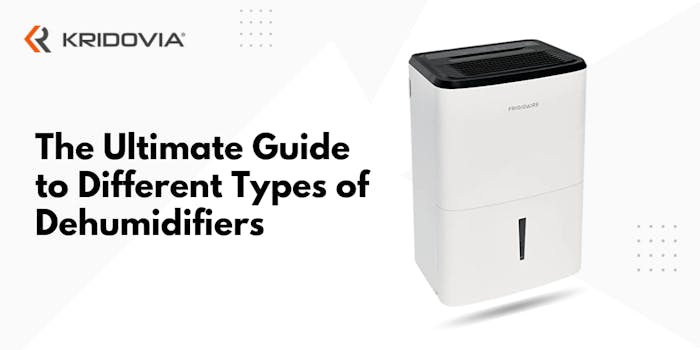Also Read: The Ultimate Dehumidifier Buying Guide By Kridovia
Types Of Dehumidifiers:
The first step in choosing the right dehumidifier is to know a lot about the types of dehumidifiers on the market. Three kinds of dehumidifiers are on the market: a refrigerant, a desiccant, and a whole house. Each of these dehumidifiers collects moisture differently, and knowing this will help you decide which one to buy.
Condensate Dehumidifiers
Condensate dehumidifiers use a cold device to collect water from the air. This water, called condensate, is usually greywater, a type of wastewater that doesn't contain waste, but the condensate is sometimes used in industry. Some companies use reverse osmosis filters to turn the condensate into drinkable water. Some types of dehumidifiers, like the ionic membrane dehumidifier, remove moisture by turning it into a gas instead of a liquid.
Electric Dehumidifiers That Use Refrigeration:
Electric dehumidifiers that work with refrigeration are very common. They use a fan to move moist air over a cooled evaporator. These evaporators can have either a coiled tube, a fin and tube, or a microchannel. The cold evaporator of the refrigeration unit collects the water, which is then taken away. A condenser coil then heats the air. The rewarmed, dehumidified air is then sent back into the room. These dehumidifiers work best when the dew point temperature is high, and the room temperature is high. In cold places, they don't work as well.
Spray Dehumidifiers:
Spray dehumidifiers cool water below the air's dewpoint so that more water from the air condenses on the water than evaporates from it. They mix sprays of cold water and air to get the moisture out of the air. They also catch pollutants and contaminants like pollen; if used to clean the air, they are called "air washers."
Whole-House Dehumidifiers:
This is a system for removing moisture from the air in the house. People think these are the most effective dehumidifiers, especially for larger rooms.
Dehumidifier types are used for other things. Most bedroom dehumidifiers for sale say they are "small and quiet." These are for smaller rooms, like a bedroom, and make less noise than the bigger ones.
Technically, all dehumidifiers stop mould growth, but ventilation systems also remove condensation from the whole house and work like dehumidifiers. Most of the time, though, these are bigger and have more power than other dehumidifiers. They will be on the more expensive side because of this.
Ionic Membrane Dehumidifiers:
Ionic membrane dehumidifiers use an ionic membrane to move moisture into or out of a sealed area. This types of dehumidifier work at the level of molecules. They use an SPE membrane, which stands for solid polymer electrolyte. They are steady-state dehumidifiers with low power that work well in small spaces where maintenance may be difficult. Most SPE systems could be better at getting rid of water. Because they get rid of water vapour through electrolysis, they don't need much maintenance. They also don't use much electricity and have no moving parts, so the ionic membranes work quietly and reliably. SPE dehumidifiers often remove humidity from sensitive electrical components, medical equipment, museum items, or scientific equipment.
The SPE has a solid polymer electrolyte that conducts protons and porous electrodes with a layer of noble metal particles that acts as a catalyst. When a voltage is applied to the porous electrode connected to the membrane, the water on the anode side (the side that removes moisture) breaks apart into hydrogen ions and oxygen. The hydrogen ions pass through the membrane to the cathode side, reacting with oxygen in the air on the moisture-discharging side. Because of this reaction, water molecules are let go. The side that gets rid of moisture allows oxygen.
Dehumidifiers That Use Chemicals:
Chemical absorbent dehumidifiers, also called desiccant dehumidifiers, dry the air using hydrophilic materials like silica gel. Silica gel is also used to absorb moisture in packets in shoe boxes. The dehumidifier pulls in air and sends it over a wheel of silica gel that turns. Gel, or any hydrophilic material, absorbs moisture from the air and stores it in the gel wheel.
A small amount of air is heated and sent back through the wheel. This is called "reactivation air." Any moisture in the rotation is then released into this air stream, making the gel wheel work again. The warm, moist reactivation air comes from the unit and is let out of the dehumidified area.
Desiccant dehumidifiers work best in cold places, have low humidity, or need deep drying. Since they don't make condensation, there is nothing to freeze, so that they can work in temperatures below zero. Because they don't have a compressor, they tend to be much quieter than other industrial or commercial dehumidifiers.
Conclusion:
Learning about the different kinds of dehumidifiers on the market will help you choose the one that best fits your needs. In the summer, high humidity is very uncomfortable. The harder it is for the body to release heat into the air, the more humid it is.







